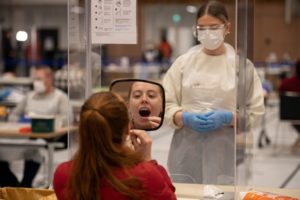Since they were first introduced, lateral flow tests have been controversial: some scientists have suggested that they miss a large number of cases. Others warned that they will pick up a large number of otherwise undetected infections, and so reduce the overall number of cases.
At the moment, they’re free, at least for users. The Government will provide them, in packs of seven, to anyone who asks. But is that going to stop? There was confusion over the weekend after one “senior Whitehall source” told the Sunday Times that it would — before the education minister, Nadhim Zahawi, informed Sky that there were no such plans.
Maybe it’ll happen soon, maybe it won’t. But we are moving towards a world in which we need to think differently about testing for Covid; the current scenario — free tests for anyone who wants them, followed by automatic isolation if you have a positive result — cannot continue forever.
The question now is: what should replace it? Will it soon be time to start using tests in new ways – to let people decide whether they ought to stay home, rather than ordering them to via restrictions? And will we start doing the same for diseases other than Covid?
First, let’s be clear about something: the cost of LFTs has been low. The figure usually quoted is £6 billion — which seems tiny when compared to the £315 billion spent on Covid measures (as of December 2021), not to mention the vast economic damage inflicted since March 2020. Economists often talk about “Treasury brain”, the desire to cut any and all spending without asking whether that spending is actually saving money elsewhere. I suspect the call to stop giving away LFTs is an extreme case of Treasury brain: lateral flows don’t have to stop all that many infections to pay for themselves many times over.
And they probably do stop a lot of infections. LFTs are less sensitive than the standard PCR tests, but they are much quicker — minutes rather than hours — and, unlike PCRs, will not detect dead virus in the system of someone who has been recovered for days or weeks. “I’ve always been a big advocate,” says Prof Alan McNally, a microbiologist at the University of Birmingham. In particular, they are more likely to return a positive result when you have a high viral load and, therefore, are more likely to be infectious. He points to various studies, including this modelling paper in the Lancet Public Health journal, which seem to find that LFTs followed by self-isolation lead to significant drops in transmission.
That said, we should still be wary. LFTs definitely miss some non-trivial fraction of cases, including some which are infectious. Alexander Edwards, a professor of biomedical technology at the University of Reading, notes that one recent preprint followed 30 people who had tested positive for Covid on PCR while doing LFTs at the same time. It found, as expected, that PCRs tended to pick up the infection earlier and more reliably. But it also found, through contact tracing, that four people passed on the virus in between negative LFTs. It’s a tiny study, and we have no way of knowing how common events like that are. But they do happen: you can’t 100% rely on LFTs telling you whether you’re infectious or not.
But LFTs have always been in a bit of a strange situation. On the one hand, there is a tendency to assume that they are outranked by PCRs. I know at least one person who had a positive LFT followed by a negative PCR, and assumed that meant the LFT was wrong and they could go back to work. But that’s wrong. “I’m always astonished by this,” says McNally. “If you have symptoms, and you take an LFT and it’s positive, then you have Covid. The idea that PCRs trump LFTs is baffling.”
There have been calls recently to drop PCRs altogether — for Test & Trace to rely entirely on LFTs — and that makes sense to me: even if PCRs are somewhat more sensitive, they’re much more expensive and they take two days to give you a result. An imperfect result now is better than a somewhat more accurate one after you’ve been spreading the virus (or needlessly locked at home) for two days.
On the other hand, there’s a contradictory tendency: to think of LFTs as definitive. I notice this in myself: I’ll say things like “Ah, good thing I don’t have Covid!” when I test negative, rather than virtuously thinking “Well, this new evidence supports my hypothesis that I do not have Covid.” No medical tests are 100% accurate — some number of negatives (and positives, although that’s rarer with Covid) will be false. “I’ve always been nervous that people will think that if they have a negative PCR it’s fine to go and see their family,” says Edwards. “And that’s not true.” He worries that overenthusiastic supporters of LFTs “overemphasise how good they are”, and potentially undermine trust in them when false negatives happen.

PCRs are not as reliable as you might think
But we are moving into a new phase of the pandemic, and trying to return to as normal a life as possible. At the moment, Covid is a “notifiable disease”: that is, if you are diagnosed with it, the Government must be informed. But if we are to “live with the virus”, then at some point that will change; we don’t inform the government when we have a cold, or the flu. Likewise, we’ll need to stop informing the Government of every asymptomatic infection or mild case of Covid-caused sniffles.
It’s unclear when that will be, although my own feeling is that it should be relatively soon: a few months’ time, at most, assuming future variants aren’t much more dangerous. Certainly, we should be thinking about reducing the isolation period for positive tests, and letting people make their own judgments about isolating. (We implicitly do this already, since the whole thing runs on an honour system: if you want to fake a negative LFT test, it is trivially easy to do. We’re relying on people’s honesty as it stands.)
But once we do move away from notifying the Government about Covid cases, LFTs are still going to be a vital part of the world. We will need to think of them neither as PCRs’ inadequate cousins nor as golden tickets allowing us to enter our elderly relatives’ nursing homes free of danger, but as useful tools in our risk assessment.
If you’re going to visit your elderly parents, and you’re all triple-vaccinated, and you have no reason to think you have Covid, then you might feel pretty safe already and use an LFT to add an extra layer of reassurance. Likewise, shops, pubs and theatres might also want to call for customers to show a negative LFT result in order to reduce the number of Covid infections among their patrons and staff — it won’t remove every one, but it will reduce the risk.
What’s going to be really interesting, though, is how Covid changes our attitudes to diagnostic testing in general. “It has democratised it,” says McNally. Before now, infectious-disease testing was something done in labs, by doctors and scientists. But now we’re all extremely capable of sticking a simple cotton swab up our nose and using that to test for Covid, at home.
But we don’t have to do that just for Covid. I recently spoke to Pantelis Georgiou, a professor of electrical engineering at Imperial College London. He’s developing what seems to be the natural successor to LFTs: “lab on a chip” technology that can test for a variety of pathogens, whether viral, bacterial or other, as quickly as LFTs. It has been used to detect malaria in Ghana, and, he told me, has been shown to work for TB, aspergillus and dengue, among other other things.
The most interesting thing to me, though, is that it doesn’t need to be specific to a single disease. “We are working to roll out a version that looks for the top five respiratory or fever-causing pathogens,” he told me. So you could do a simple swab test, and it will tell you in minutes whether the cold symptoms you have are Covid, or the flu, or a rhinovirus.
“I think it could really change how people regard having symptoms,” says McNally. For instance, imagine you often get snotty, and you’re not sure whether it’s just allergies or a virus. In future, you might be able to test, and use the result of that test to help you decide what to do — you might feel comfortable going into the office with a confirmed cold or a negative result, but not with an influenza virus or Covid, for instance.
That’s for the future. For now, LFTs do a good job, as long as we see them as risk-reduction tools rather than infallible oracles. “The actual cost of producing one is pennies,” says McNally — most of the £5-or-so price tag at the moment represents the cost of building factories, and logistical issues like boxing and transport, costs which will fall. “You could see a situation where you can buy a pack of seven for £10, and that would really change things.” In future, maybe they’ll be like paracetamol, just something that everyone has in their cupboards.
For now, I suspect that keeping them free is the best option, contrary to the Treasury-brain instinct — although perhaps some nominal cost would stop people stockpiling them when demand is high. Rather, the next change should not be to how we provide them — it should be to how we react to them. And that is to rely on the results, rather than double-checking them with PCR. Meanwhile, with a 90% vaccinated population, we can surely put an end mandatory isolation, and start trusting people to make their own decisions about risk.
Disclaimer
Some of the posts we share are controversial and we do not necessarily agree with them in the whole extend. Sometimes we agree with the content or part of it but we do not agree with the narration or language. Nevertheless we find them somehow interesting, valuable and/or informative or we share them, because we strongly believe in freedom of speech, free press and journalism. We strongly encourage you to have a critical approach to all the content, do your own research and analysis to build your own opinion.
We would be glad to have your feedback.
Source: UnHerd Read the original article here: https://unherd.com




